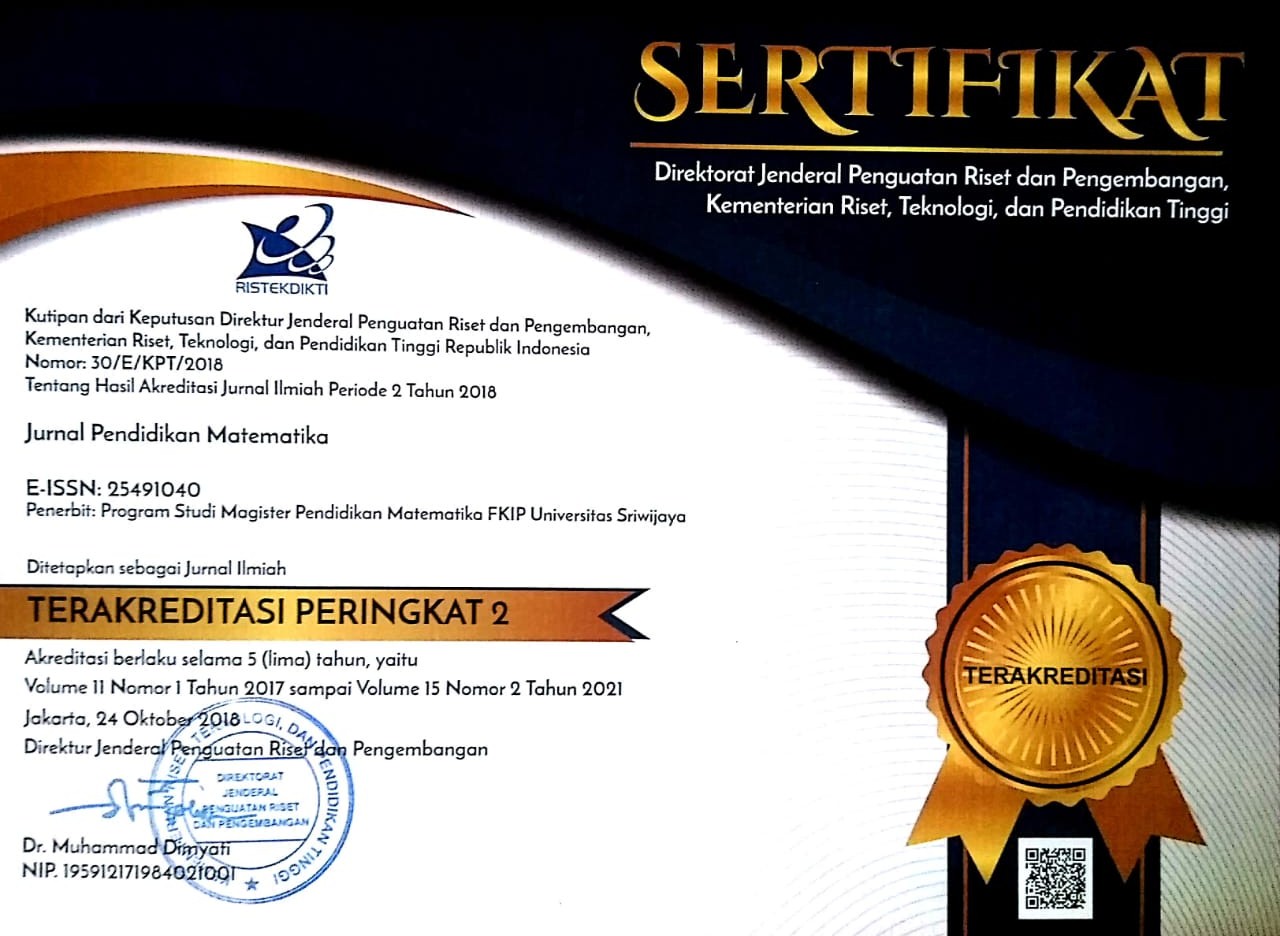STRATEGI DAN TINGKAT KEPEKAAN BILANGAN SISWA SEKOLAH DASAR DALAM MENYELESAIKAN MASALAH OPERASI BILANGAN BULAT
Abstract
Keywords
Full Text:
PDFReferences
Bobis, J. (1991). The effect of instruction on the development of computation estimation strategies. Mathematics Education Research Journal, 3, 7-29.
Case, R. & Sowder, J. (1990). The development of computational estimation: A neoPiagetian analysis. Cognition and Instruction, 7, 79-104.
Cobb, P., Wood, T ., Yackel, E., Nicholls, J., Wheatley, G., Trigatti, B., & Perlwitz, M., (1991). Assessment of a problem-centred second-grade mathematics project. Journal for Research in Mathematics Education, 22, 3-29.
Dehaene, S. (2011). The number sense: how the mind creates mathematics. Noe York: Oxford University Press.
Devlin, K. (2017). Number sense: the most important mathematical concept in 21st Century K-12 education. HUFFPOST, (online), (http://www.huffingtonpost.com/entry/number-sense-the-most-important-mathematical-concept_us_58695887e4b068764965c2e0).
Fauzan, A. (2002). Applying Realistic Mathematics Education (RME) in Teaching Geometry in Indonesian Primary Schools. Doctoral Dissertation. The Netherlands: University of Twente.
Fischer , F. (1990). A part-part-whole curriculum for teaching number to kindergarten. Journal for Research in Mathematics Education, 21, 207-215.
Fosnot, C.T., & Dolk, M., (2001). Young Mathematician at Work: Constructing Number sense, addition, and substraction. Porstmouth, NH: Heinemann.
Freudenthal, H. (1991). Revisiting mathematics education. The Netherlands, Dordrecht: Kluwer Academic.
Hope, J., & Sherril, J. (1987). Characteristics of unskilled and skilled mental calculators. Journal for Research in Mathematics Education, 18, 98-1 1 1.
NCTM. (2000). Principles and Standars for School Mathematics. Reston, VA: NCTM
Neergaard, L. (2013). Early Number sense Plays Role in Later Math Skills. ABC News, (online), (http://www.abc2news.com/news/health/early-number-sense-plays-role-in-later-math-skills).
Putrawangsa, S. (2013). Educational Design Research: Developing Students’ Understanding of The Multiplication Strategy in Area Measurement. Master Thesis. Surabaya: Universitas Negeri Surabaya.
Putrawangsa, S. (2015). Students’ prior understanding of area. Beta Jurnal Tadris Matematika, 8 (2), 113 – 126.
Paulos, J.A. (1988). Innumeracy: Mathematical illiteracy and its consequences. New York: Vintage
Reys, Robert E., and Nobuhiko Nohda, eds. (1994). Computational alternatives for the twenty-first century: cross-cultural perspectives from Japan and the United States. Reston, Va: National Council of Teachers of Mathematics.
Ross, S. (1989). Parts, wholes, and place value: A developmental view. Arithmetic Teacher, 36, 47-51.
Sowder, J.T. (1992). Making sense of numbers in school mathematics. In Analysis of Arithmetic for Mathematics Teaching, edited by Gaea Leinhardt, Ralph Putman, and Rosemary A. Hattrup, pp. 1–51. Hillsdale, N.J: Lawrence Erlbaum Associates.
Trafton, P. (1992). Using number sense to develop mental computation and computational estimation. In C. Irons (Ed.) Challenging Children to Think when they Compute . (pp. 78-92). Brisbane: Centre for Mathematics and Science Education, Queensland University of Technology.
DOI: https://doi.org/10.22342/jpm.12.1.5066.15-28
Jl. Srijaya Negara, Bukit Besar
Palembang - 30139 Indonesia
Jurnal Pendidikan Matematika is licensed under a Creative Commons Attribution-NonCommercial-ShareAlike 4.0 International License.
Indexed in:


